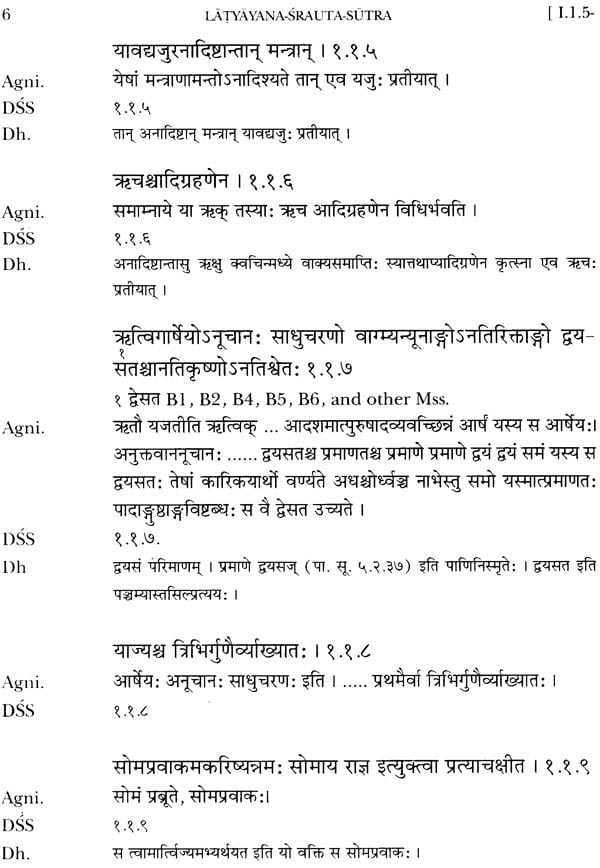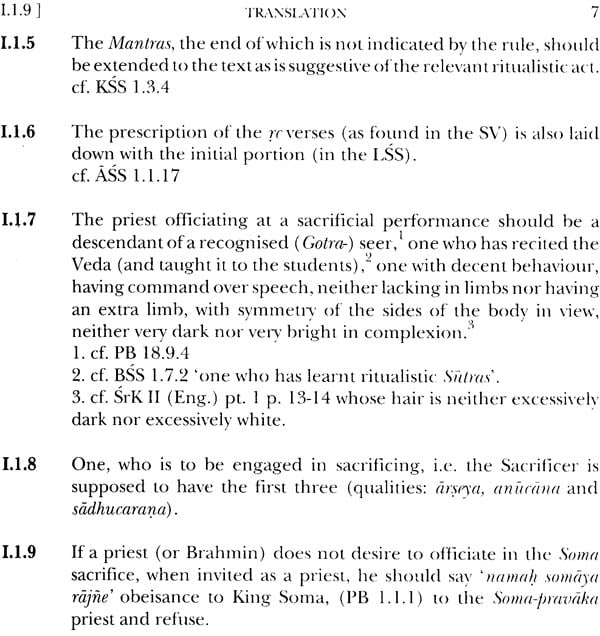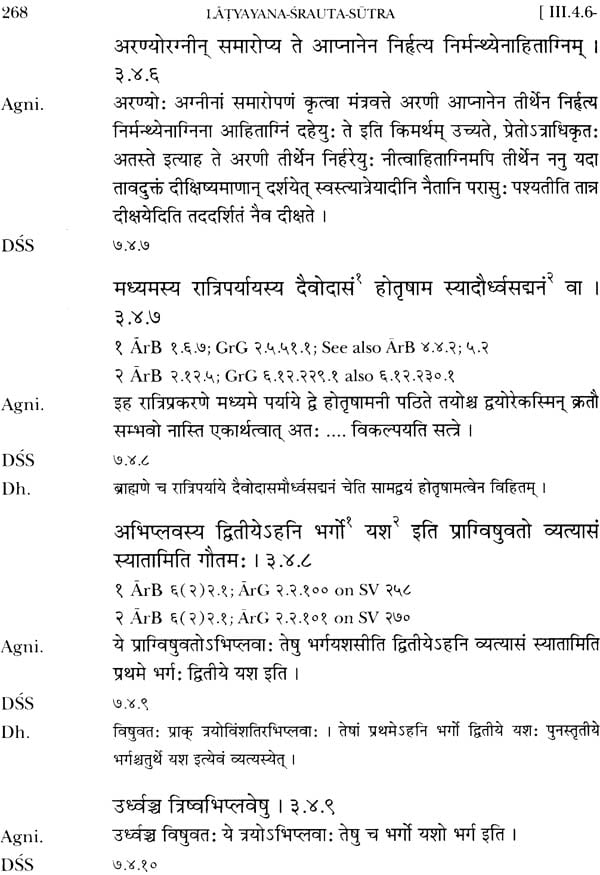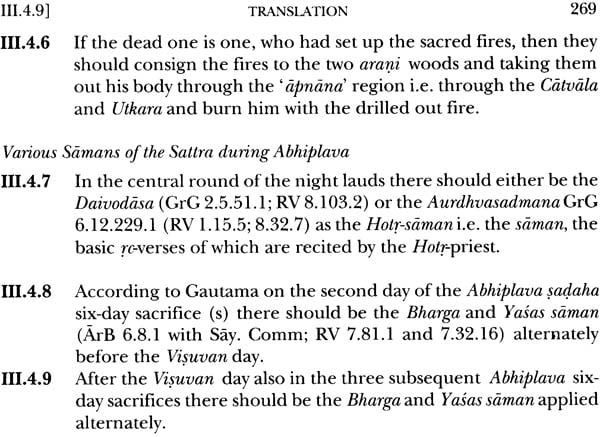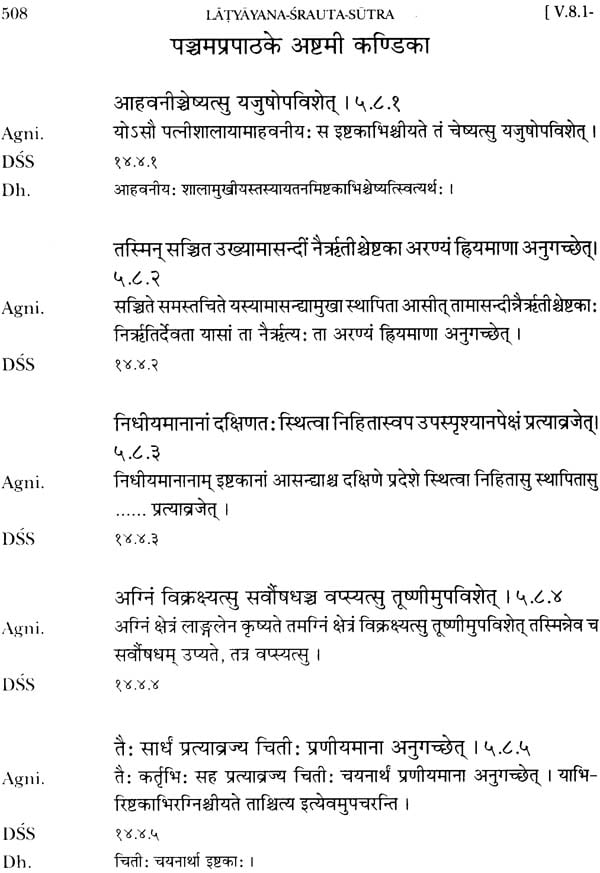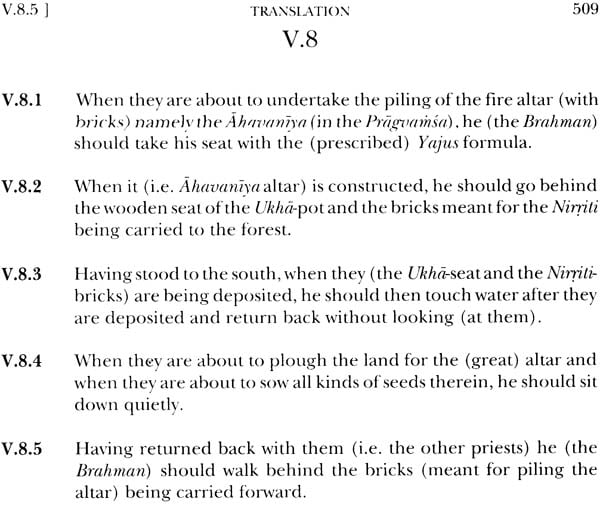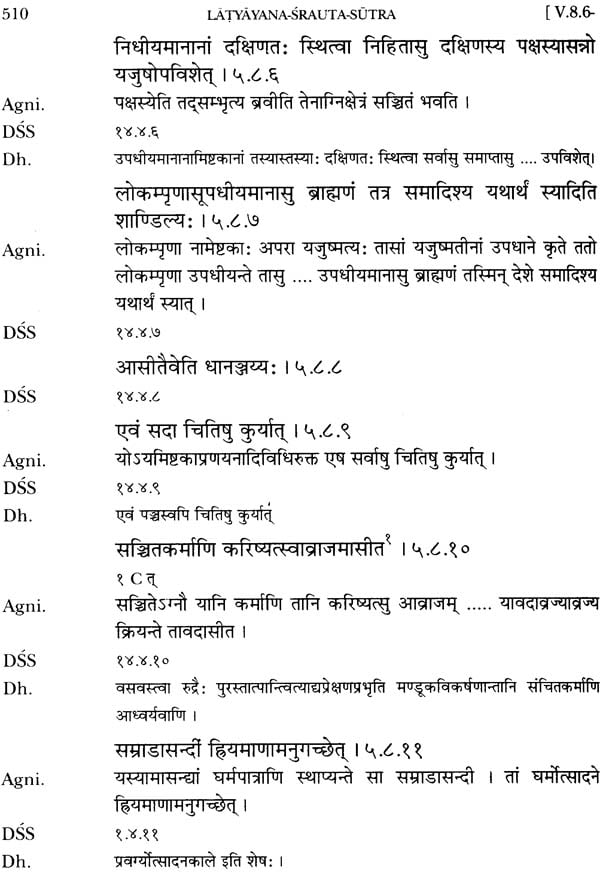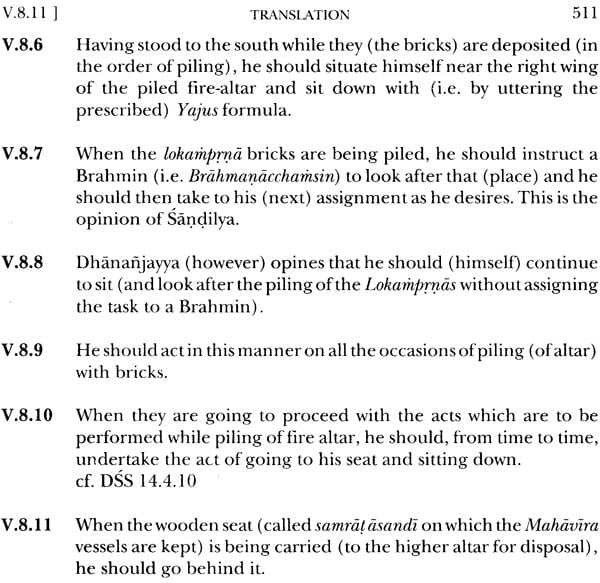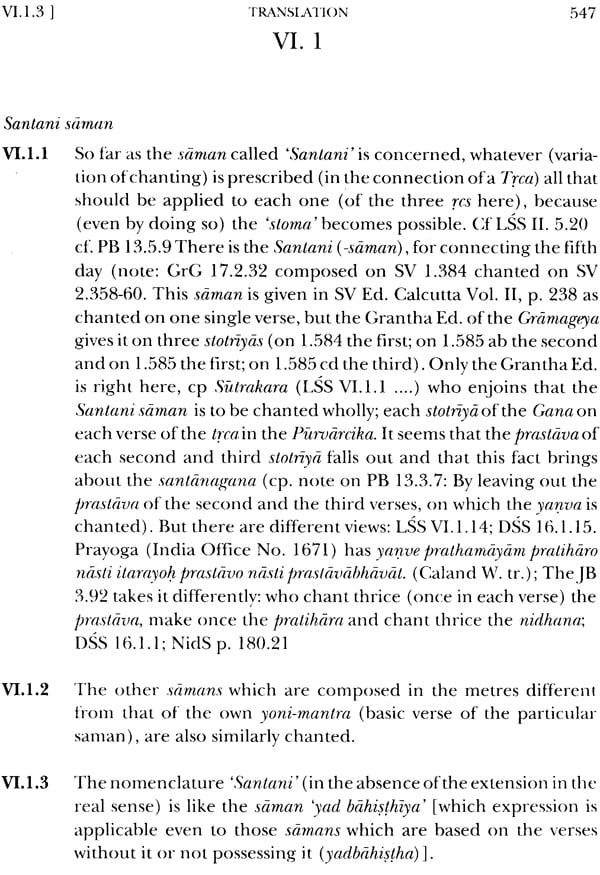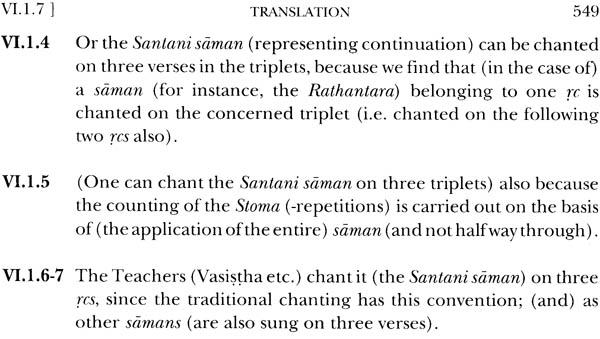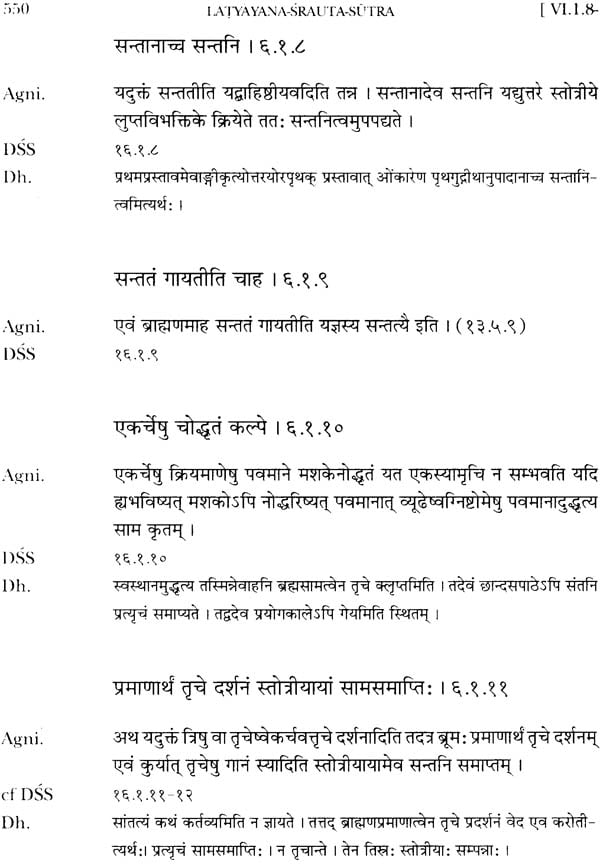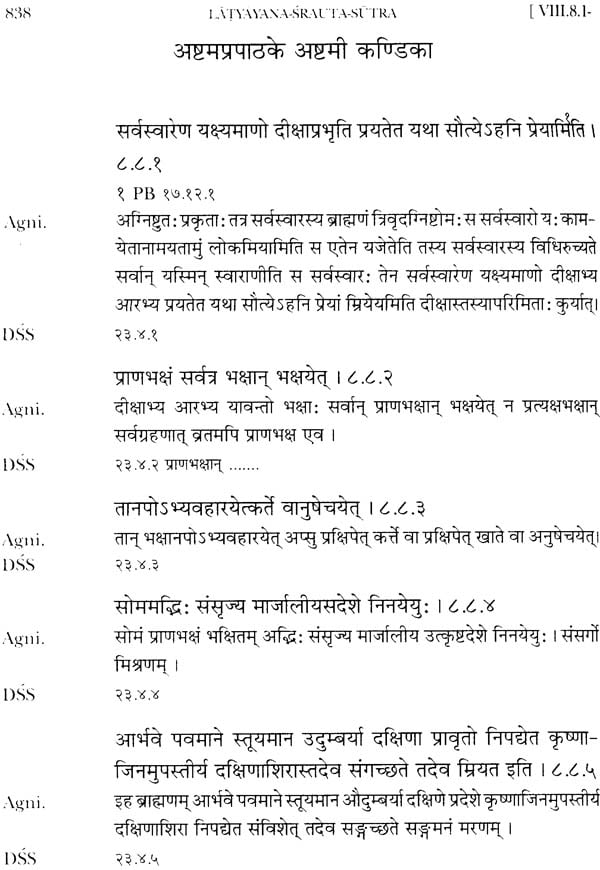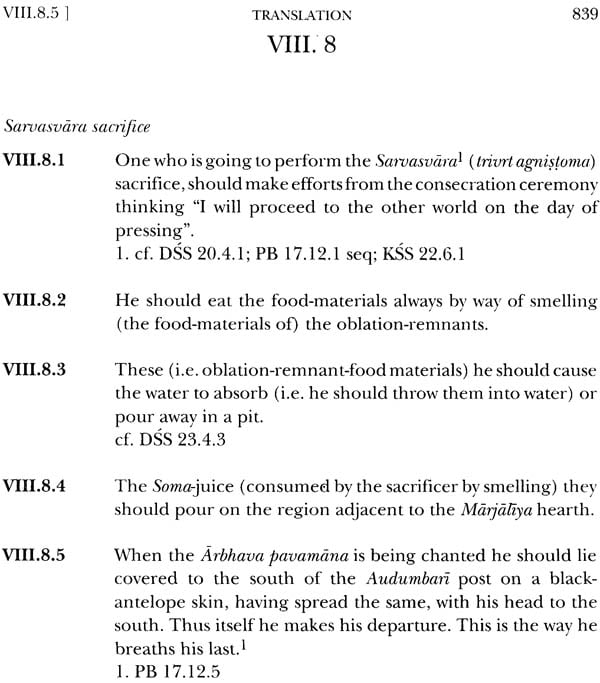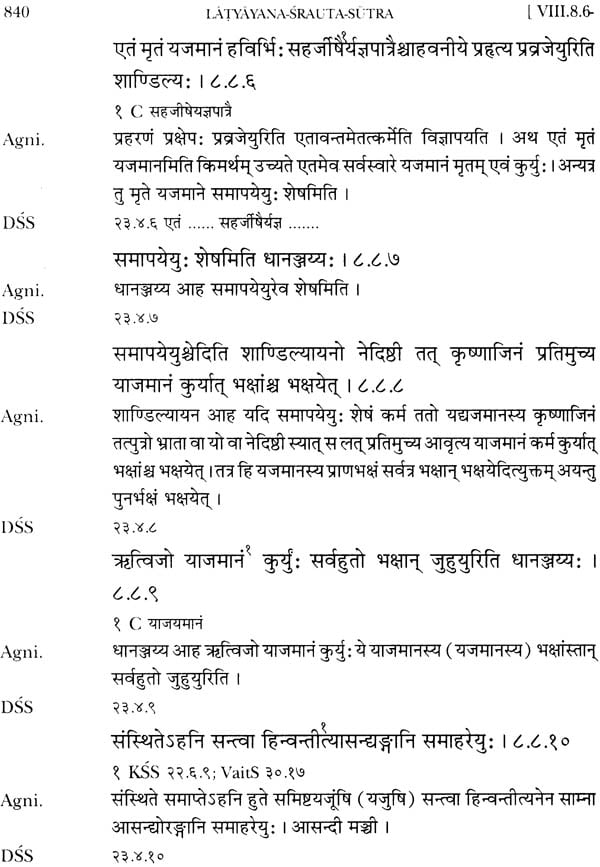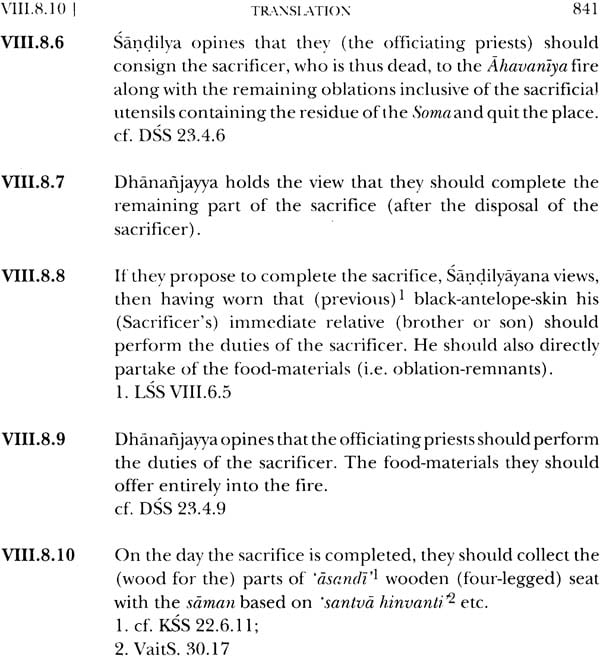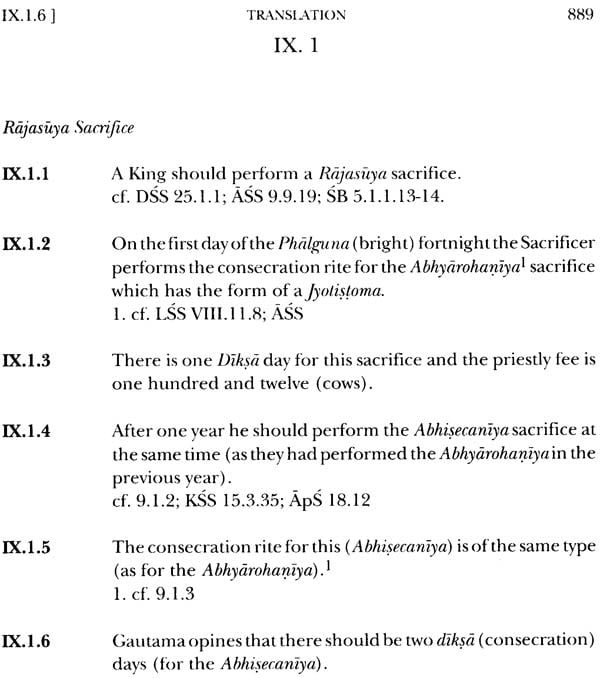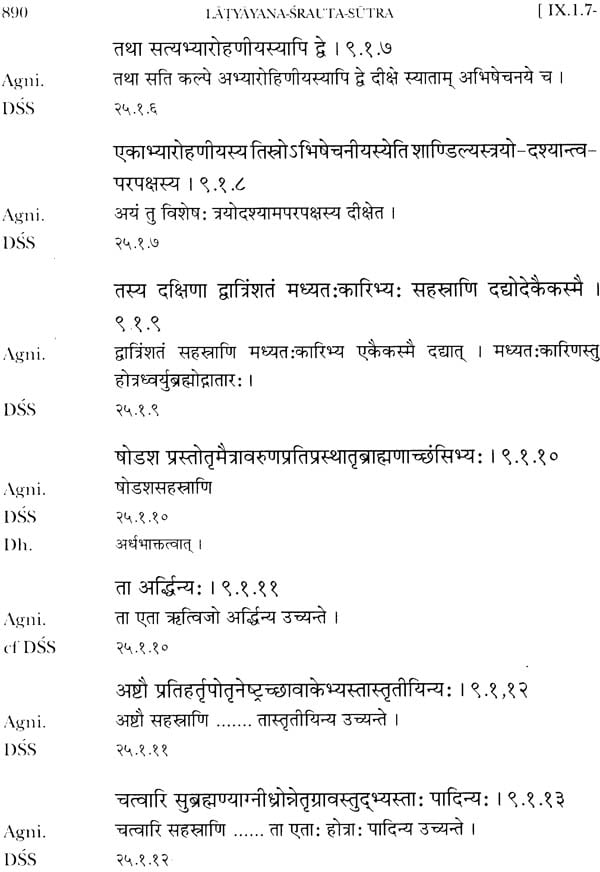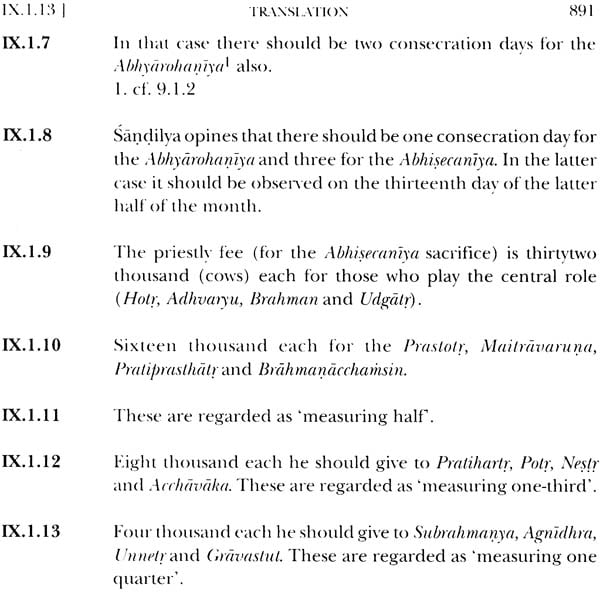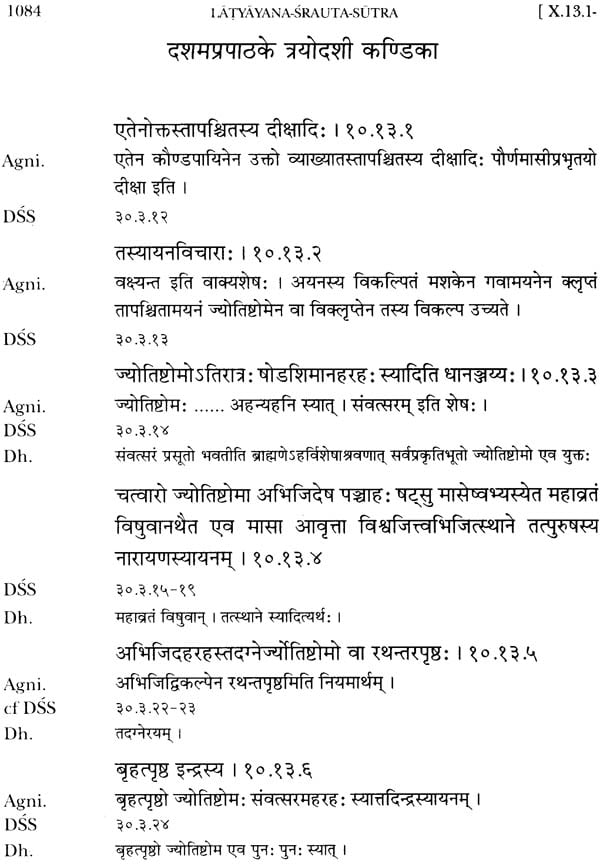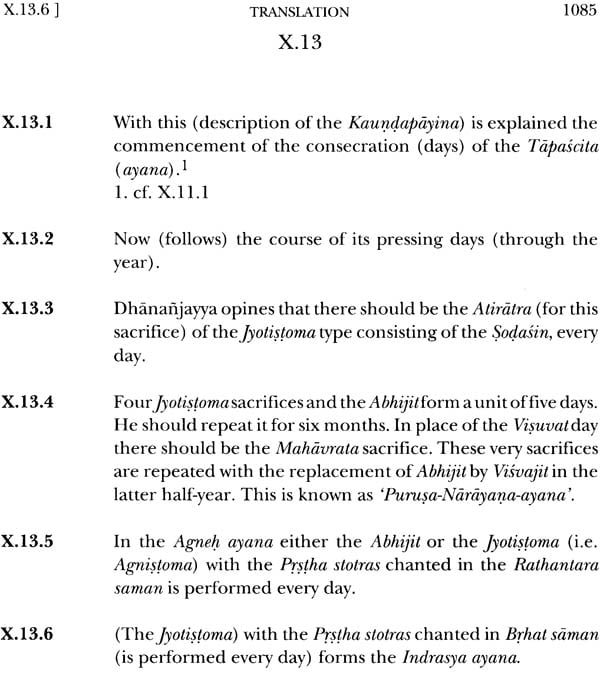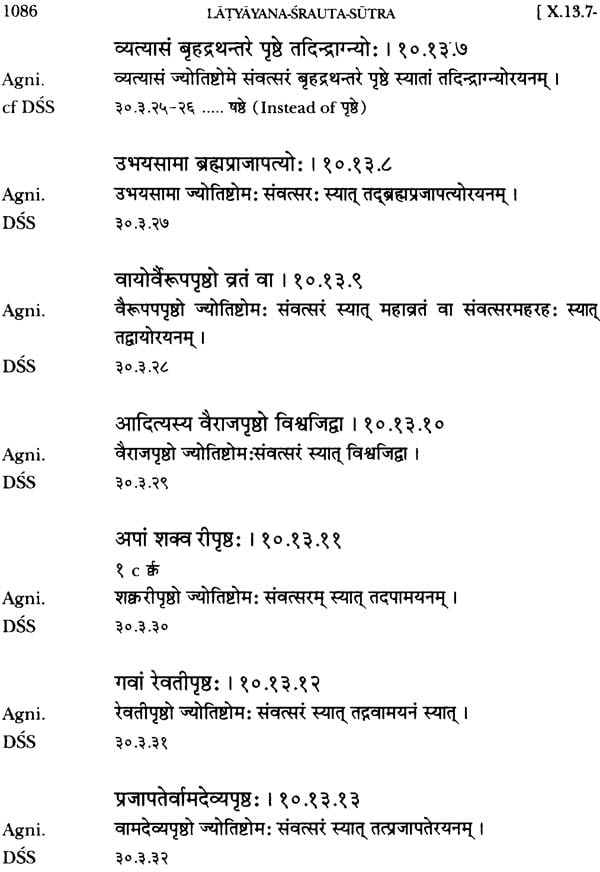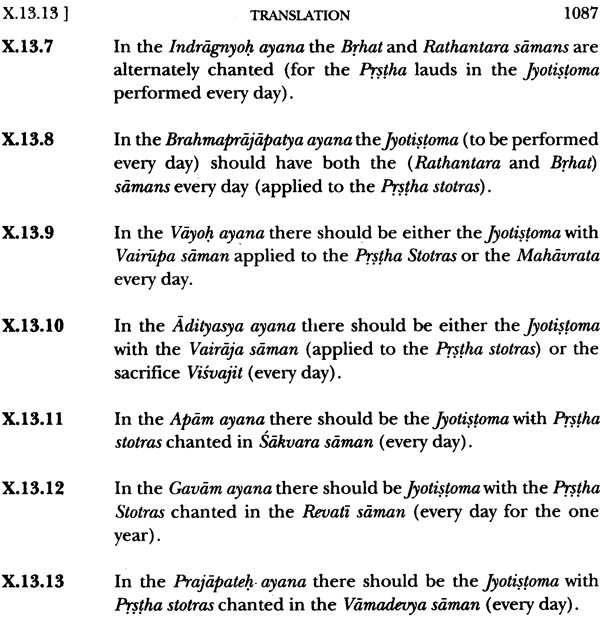
Latyayana-Srauta-Sutra in Three Volumes
Book Specification
| Item Code: | IDJ556 |
| Author: | H.G. Ranade |
| Publisher: | Indira Gandi National Center for the Arts, New Delhi & Motilal Banarsidass Publishers Pvt. Ltd. |
| Language: | (Sanskrit Text with English Translation |
| Edition: | 1998 |
| ISBN: | 8120815653 |
| Pages: | 1266 |
| Cover: | Hardcover |
| Other Details | 9.7" X 7.1" |
| Weight | 4.12 kg |
Book Description
About the Book
The Srauta Sutras form a very important unit of the Sutra Literature which lays down in brief the quintessence of the Vedic texts i.e. the Samhitas and the Brahmans strengthening further the sacrificial tradition in India. As it is known worldwide, the sacrificial tradition in India is based mainly on the oldest book of the human beings namely the Rgveda (RV) as also on the Yajurveda (YV) and the Samaveda (SV) which have developed a variety of recensions with difference of utterance and practice.
Although there are a 'mille' recensions of the Samaveda mainly based on the singing of the verses in RV, only three are found in practice today: 1. Kauthuma 2. Ranayaniya and 3. Jaiminiya or Talavakara. The Latyayana Srauta sutra (LSS) which is critically edited here and translated into English dealing with the duties of the chanting priests viz. the Udgatars, Prastotar, Pratihartar and Subrahmanya in the Srauta ritual with special reference to the Soma sacrifice, belongs to the Kauthuma recension, largely depending on the SV samhita and Pancavimsa Brahmana (which is also known as Tandya MahaBrahmana) as also the Sadvimsa Brahmana.
It regards the Arseya or Masaka Kalpa as the authority. The Drahyayana Srauta Sutra shows a reasonable similarity with the LSS; but it definitely improves upon the former. In its comprehensive treatment of the Srauta ritual the LSS can be compared with the sutras of the Yajurveda namely the Baudhayana, Apastamba, Manava and Katyayana.
Along with the duties of the chanters (Udgatrs) in Ekaha (one day) Ahina (multiday) and Sattra (session) Soma sacrifices it has concerned itself with the role of the Brahman Priest in Soma and various other sacrifices. Beside improving upon the extant edition, it can be specifically mentioned that the present edition traces an additional sutra found recorded in the Varanasi MSS with reference to the Sarpa-yajna (serpent-sacrifice).
About the Author
Prof. Dr. H.G. Ranade, currently the Coordinator and editor of the Sanskrit-English Encyclopaedic Dictionary on Historical principles at the Deccan College, Pune had the honour of completing his education with first class throughout and did his Ph.D. on 'the study of Satapatha Brahmana as a commentary' on the Vajasaneya samhita' from the University of Bombay in 1970. Being in the profession of teaching and research he has developed a special liking for vedic ritual, the tradition of which is found dwindling now-a-days. After completing his first English translations of the Katyayana and Asvalayana-Srauta-Sutra (published in 1978, 1983-86) he is inclined to present here his critical edition of Latyayana-Srauta-Sutra with his first English translation under the auspices of the IGNCA. Enriching his aquaintance with the Vedic ritualistic terminology with these editions and translation he naturally proposes to work on the Illustrated, Dictionary of Vedic Rituals. He had also the opportunity to attend the performance of the important Soma sacrifice in India and later deliver lectures on the Vedic rituals abroad holding thereby discussions on problems therein with the scholars of the world. It is hoped that his wide experience and contributions of Vedic rituals will definitely benefit the readers.
Foreword
The Latyayana-srauta-sutra (LSS) is now being presented as the volume numbers 27, 28 and 29 of the Kalamulasastra series of the Indira Gandhi National Centre for the Arts (IGNCA).
The LSS belongs to the Kauthuma recension of the Samaveda and is known primarily as a text on liturgy and chanting, related chiefly to the Somayagas.
The Kalamulasastra series aims to publish seminal texts on Indian artistic traditions, in the fields of music, architecture, sculpture, and painting etc. Since the IGNCA believes that the artistic traditions of India are not isolated, but are integral parts of a unified vision and world-view which is visualized in the Vedas, Agamas and Puranas, the planning of the series has been broad-based. Keeping this objective in view Vedic texts such as the Kanvasatapatha-brahmana, Agamic texts such as the Kalikapurance Murtivinirdesash, along with architectural texts such as the Mayamata and the Silpatnakosa, music texts such as the Matralaksana, Dattilam, Brhaddesi and dance texts as the Srihastamuktavali, Nartananirnaya have already been published in the series. A few more texts to these classes are published and are in various stages of editing and publication.
In the Foreword of the Kanvasatapatha-brahmana Volume I, attention has been drawn to the fact that the methods of ritual and the speculative thought are parts of a single whole. While the Vedas are the perennial source, several inter-related streams flow with distinctive emphasis on method, significance and process. Together they provide the foundation of the Indian arts. It is well known that the Vedic literature comprising the Vedic hymns (mantras), the Brahmans, the Aranyakas and the Upanisads and the Kalpasutras constistute a well-knit and integrated corpus. The hymns (mantras) are considered to be 'revelations' (drsta) because they are inspired by an intuitive insight and 'flash'. Little wonder while the Sruti (Vedic corpus) has remained immutable, its interpretation at the level of thought, intellection and systematized application have been many.
While the Upanisads speculate on the nature of the Universe and the relationship of the One and the Many, the immanent and the transcendental, the Brahmans make the world-view and the concepts concrete through a highly developed system of rituals, yajnas.
As is well known the Vedic liturgy was first formulated and detailed in the Brahmana texts. They make explicit and concretize a comprehensive philosophy of the intrinsic mutability of the micro and the macro, the gross and subtle, matter and spirit. The ritual is an enactment or re-enactment of a cosmic phenomenon.
The ritualistic procedures which have been dealt with in great details in the Brahmans are articulated in terse aphorisms (sutra) in the Srauta-sutras. The Sutras may be called the grammar and manual of the Vedic rituals.
These sutras belonging to different recensions formulate the procedures of yagas and categorically define the duties of various priests who are supposed to take part in the ritual performances. The Acaryas who composed these Srauta-sutras are held in great esteem and the great Mimamsaka Kumarilabhatta points out that all of them were rsis and their compositions contain the essence of the Vedas divided into the Mantras and the Brahmans.
The Srauta-sutras are no doubt of basic importance as ritual manuals. However, they are of great relevance to all serious students of drama. Deployment of different groups of priests to perform specific duties and to chant particular mantras, at particular junctures of a performance, has a complex and sophisticated dramatic structure. The Vedic rituals as described and prescribed in these sutras thus contain the seeds of Indian dramatic theory and practice. In this connection it is pertinent to recall the first chapter of the Natyasastra of Bharata which states that the dramatic performance is a yajna (sacrifice). The process of chanting prescribed in the sutras also manifests a developed stage of ancient musical traditions. The Sulba-sutras which are extensions of the Srauta-sutras contain enough material on the construction of vedis (altars) and salas (sacrificial enclosures). One can also discern the application of arithmetic, geometry, and trigonometry in these Sulba-sutras. An indepth study of the Srauta-sutras is a necessary prerequisite for comprehending the development of many branches of knowledge and particularly the arts.
The Asiatic Society, the oldest institution devoted to oriental studies, recognized the importance of this class of Vedic works and brought our good editions of almost all important Srauta-sutras. This work has been carried further by premier research institute of India, such as the Bhandarkar Oriental Research Institute (BORI) in Pune, Vaidika Samsodhana Mandala in Pune, Oriental Research Institute in Mysore and Vishweshwaranand Vedic Research Institue (VVRI) in Hoshiarpur. Particular mention must be made of the edition, with English translation, of the Bharadvaja-srauta-sutra(C.G. Kashikar) brought out by Vaidika Samsodhana Mandala and the critical edition of the Asvalayana-srauta-sutra with Devarata's hitherto unpublished commentary (B.B.Chaube) brought out by VVRI. The Srauta-kosa of C.G. Kashikar is a great contribution in this field of study. Another outstanding work of this class viz. Prof. H.G. Ranade's Illustrated Dictionary of Vedic Ritual has been taken up by IGNCA for publication.
The LSS chiefly deals with the duties of the chanting priests, viz. Udgatr, prastotr, Pratihartr and Subrahmanya in the Srauta ritual, with special reference to the Soma yagas. Since the Saman chanting is believed to be the fountainhead of all Indian musical traditions, the LSS has special bearing on these traditions. Readers of LSS would be interested to compare the contents of LSS with those of Matralaksana (Kalamulasastra volume I). The latter text has been stated in the Foreword of the volume I to be of fundamental importance because for the first time concept of a time-unit measure (matra) is fully discussed. We had observed that the importance of matra as measure with the mathematical syllabic time value of vowels in their aspects of elongation, tempo, pitch and interval cannot be understood without taking into account sound as measure. In delineating the semantic relationship between syllable and letter, vowels and consonants it lays the foundation of disciplines today recognized as phonetics, linguistics and prosody. Equally important is the discussion on sound and notes, in doing so it is a proto fore-runner of the 'modal' system of Indian music. As an exacting system of oral articulation and recitation, this text was used for recitation with hand gestures like arcika. In relating the articulation of sound with body language, gesture, especially hands and fingers, the system of orally rendering a text according to its manuals, provides the basis of the emergence of a structure of artistic expression through the body (namely angikabhinaya). In more senses than one, Vedic intonation is a precursor of both theory and practice (sastra and prayoga) of the arts, in their original framework of inter-relatedness.
The LSS goes further; it not only analyses the samans to be chanted in various sacrifices, accent by accent and tune by tune, but also mentions the accompanying musical instruments such as the vinas and dundubhis. In the Latyayana-srauta-sutra (IV.1-2) we come across the names of different types of vinas such as Alavu, Apaghatila, Kapisirsni and Vakra. The technical method for making these vinas and a special beating instrument named bhumi-dundubhi has also been described in great detail (IV.I).
Another important text on the subject is the Puspasutra which will also be published in this series.
The LSS with the commentary of Agnisvamin, was edited for the first time by Pandit Anandacandra Vedantavagisa and published by the Asiatic Society of Calcutta as number 181 (new series) m the Bibliotheca Indica in 1872. Mukunda Jha Bakshi also edited first two chapters of the text (upto the end of Agnistoma) with his commentary, Sarala, ( Chowkhamba, 1932).
Though Pt. Anandacandra Vedantavagisa collated several manuscripts and compared the text with the Drahyayana-srauta-sutra, a parallel text of the Ranayaniya recension of the Samaveda, his edition can hardly be called a critical one. The text has never been translated in any language. It has, therefore, been a long felt desideratum to publish a critical edition on the basis of fresh manuscript material and especially to bring out an annotated English translation.
IGNCA is grateful to Professor H.G. Rande, presently Chief Editor of the Sanskrit Dictionary Project of the Deccan College in Pune, for taking up this arduous task for the Kalamulasastra. Prof. Ranade is a well-known specialist of the Srauta-sutra traditions and has already made commendable contributions to this field of study. He has a strong traditional background in Sanskrit learning and very good access to the up-to-date research material through his polyglot scholarship. He has a strong traditional background in Sanskrit learning and very good access to the up-to-date research material through his polyglot scholarship. He has critically edited the text on the basis of twelve manuscripts, some of which reflect the oral transmission of the text. He has judiciously quoted extracts from the Commentary of Agnisvamin, wherever he thought it necessary for better understanding of this terse text. He has also meticulously compared LSS with the Drahyayana-srauta-sutra and noted variants from the latter. Extracts quoted from the Commentary of Dhanvin on the Drahyayana-srauta-sutra are also useful for understanding the technicalities of the text. The English translation and, in particular, the annotations which incorporate partial translation of the Commentary represent the traditional interpretation. I fervently hope that the labour and insight of Prof. Ranade will be deeply appreciated by the scholars who are engaged in Vedic Studies and others who wish to delve more deeply into the roots of the Indian artistic tranditions.
Pandit Satkari Mukhopadhyaya, Coordinator of the Kalakosa Division has taken great pain to ensure the accuracy of the edition. Dr. (Smt.) Sanghamitra Basu, Senior Research Fellow in the Kalakosa Division has read the proofs and compiled the Sutra index. My sincere thanks to both of them. M/s Typographia deserve our thanks for their neat and elegant typesetting of the work.
According to ancient Indian tradition there are a 'mille' thousand recensions of the Samaveda. Only three, however, are found in pratice today. They are: 1. Kauthuma, 2. Ranayaniya and 3. jaiminiya or Talavakara. The Latyayana Srauta Sutra (LSS) , which mainly deals with the duties of the chanting priests viz., the Udgatr, Prastotr, Pratihartr and Subrahmanya in the Srauta ritual with special reference to the Soma sacrifice, belongs to the Kauthuma recension.
The LSS depends largely on the Kauthuma Samaveda along with the Pancavimsa Brahmana (or the Tandya Maha-Brahmana) as also the Sadvimsa Brahmana and the Arseya Kalpa for its authority. The LSS has a very close relationship with the Drahyayana Srauta Sutra (DSS) which belongs to the Ranayaniya recension. The Jaiminiya Samhita and Brahmana along with the Jaiminiya Srauta Sutra and the Nidana Sutra have marked differences with the LSS although there are some points of agreement also. In its comprehensive treatment of the Srauta ritual the LSS can be compared with any of the Srauta Sutras of the Yajurveda: the BSS, MSS, ApS, the KSS and so on. It cites numerous schools and authorities while laying down certain rules. The teachers mentioned are Sandilya, Sandilyayana, Dhanarijayya, Gautama, Gautama Sthavira, Saucivrksi, Ksairakalambhi, Kautsa, Varsaganya, Lamakayana, Ranayani putra, Satyayanin, Salankayanin, Vajasaneyin, Acaryas in general and 'eke' (some).
Going beyond its main scope of describing the chanter's duties at the Vedic sacrifice, the Sutra deals with the duties of the Brahman priest also. A rite like Sabali-homa, which does not come under the pale of the Soma sacrifices, also forms part of its contents.
The topic-wise arrangement of the LSS is as follows:
Prapathaka I at the first place deals with the Paribhasas which define the nature of a general rule in contrast to a special one, nature of a rule in respect of a mantra, role of Udgatr as the main chan ter, essen tial qualifications of an officiating priest and his employment, nature of the sacrificial ground and the procedure to approach it. It also describes the ritual of Madhuparka (reception ofa priest) and the duties of the Subrahmanya priest who chants the Subrahmanya litany, the nature and contents of which are elaborated with all the details and types. In the fifth and sixth Kandikas of Prapathaka I, the author explains the duties of the Prastotr priest who in spite of being second in importance to Udgatr among the chanters, has the honour of beginning the 'saman ' melody as its introducer and chanting the solo samans. The names of various melodies which he is expected to sing on various occasions are enumerated here. The seventh and eighth Kandikas deal with the role of the Udgatr and from ninth to twelfth thejoint duties of all the chanters, Udgatr, Prastotr and Pratihartr in the chanting of the samans are taken up for discussion with special reference to Prasarpana and Bahispavamana and Pravrtahoma in the eleventh and twelfth.
Prapathaka II continues with the description of the Bahispavamana stotra as applied to various varieties of the Soma sacrifice: Ahina and Sattra. In Kandikas two and three of this Prapathaka the rite of praying to the hearths of various priests (in the Sadas) and different sheds erected on the sacrificial ground is taken up for detailed treatment. Kandika four describes how the Udgatr priest takes his seat in the Sadas hall. The rite of partaking the remnants of the Soma-libation is dealt with in the fifth Kandika. In the latter part of this Kandika the Upakarana rite for the assignment of the Paryaya stotras (lauds with rounds of repetition of verses) is described. 11-6 deals with the Kusas and Vistava aspects connected with the counting of verses chanted under various stotras. It also describes the passage which the chanters have to use for going out of the Sadas, if necessary. The rite of praying to the Dhisnyas (hearths) during the latter two pressing sessions of the pressing day is taken up along with the Purastat-japa (fore-muttering) and Uparistar-japa (after-muttering) for the daksina-mantra in II. 7. The aspect of japa is continued in II. 8. The rite of Prsthahorna is described in II. 2 along with the discussion of the melodies Brhat and Rathan tara applied to the Prstha-stotras of the mid-day session. The Vamadevya saman, the Arbhava pavamana, offering of rice-balls to fathers, the Yajnayajniya saman of the third session are dealt with in II. 10. Unyoking of stoma in contrast to yoking (11.5.20) is described in II. 11. It also deals with the Hariyojanagraha. The last kandika i.e. 12th of this Prapathaka describes the Avabhrtha rite of the Soma sacrifice with special reference to the chanting included in that rite. Prapathaka III deals with the following topics: Sodasi sam an and Sodasi graha, expiatory rite called Paribhaksa, Rules for the 'consecrated' in the Sattra, various samans chanted at the Sattra, Abhiplava and Prsthya sadaha, as well as in the Ahina sacrifices, Bahispavamana stotra for the ten th day, the Manasa stotra, the chanting of Pari mads under the Mahavrata sacrifice, equipping the king with an armour and beating of Bhumi-dundubhi drum under the Mahavrata.
Prapathaka IV describes the various kinds of Veena (Alabu Veena ete.) which is played as a part of the rites of Mahavrata, Abhigara and Apagara speeches, Pancavimsa stoma (employed on the Mahavrata day), Avabhrtha rite, Anubandhya and Udavasaniya Istis. In the Kandikas five to seven, the author deals with the Cavamayana yearly model sacrifice with reference to various samans applied therein. In the eighth Kandika the composition of Jyotisam ayana is described.
IV. 9 and the subsequent Kandikas describe the role of the Brahman priest in the various sacrifices. Prapathaka V: The topic of Brahman's role in the Vedic ritual is continued here with reference to the seasonal sacrifices, animal sacrifice, Sautramani and the Soma sacrifice in all its kinds including the one which is accompanied by the piling of the fire-altar. V. 11 refers to the Stoma-bhaga expressions 'rasmirasi' ete. (PB l.9.1; 15.5.24) which are to be uttered by the Brahman priest by way of anumantrana for the stotras.
| Foreword | vii |
| Introduction | xi |
| Abbreviations | xxxiii |
| Text and Translation | 1 |
| Prapathaka I | 4 |
| Prapathaka II | 128 |
| Prapathaka III | 238 |
| Prapathaka IV | 346 |
| Prapathaka V | 456 |
| Prapathaka VI | 546 |
| Prapathaka VII | 654 |
| Prapathaka VIII | 768 |
| Prapathaka IX | 888 |
| Prapathaka X | 992 |
| Bibliography | 1139 |
| Index to the name of Samans in Latyayana-Srautra-Sutra | 1155 |
| Index to Mantras in Latyayana-Srauta-Sutra | 1161 |
| Latyayana-Srauta-Sutra's Word Index | 1169 |
| Pratikasuci | 1225 |

